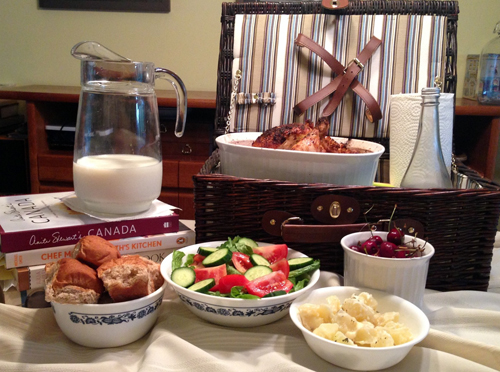
What are you cooking for Food Day Canada on Aug. 3? Prof. Erna van Duren, School of Hospitality and Tourism Management, and Julia Christensen Hughes, dean of the College of Management and Economics, compared some of the “real costs” of buying and preparing a picnic.
“We’re doing this largely from a consumer angle, so if you want to shop for, prepare and enjoy these food products, what are some of the costs involved?” says van Duren.
The hypothetical picnic meal consisted of chicken, lettuce, tomatoes, cucumbers, potatoes, cherries, bread rolls, milk and mayonnaise or whipped salad dressing for two adults and two children. The researchers “purchased” the food for each meal at five local grocery stores, four specialty retailers, three farmers’ markets and three restaurants. When they calculated the cost of the takeout meals, they added the milk and cherries from the lowest-cost sources.
The servings were based on Canada’s Food Guide to ensure the meal met the daily requirements for protein, fruits and vegetables for two adults and two children, about half of their dairy intake and just under one-quarter of their suggested serving of grain products.
“We started by looking for the lowest-price items available in each of those product categories,” says van Duren. All of the food, except for the salad dressing and mayonnaise, was fresh or chilled. The grocery stores they visited ranged from discount stores to higher-end retailers. Using the lowest-cost food they purchased at a discount grocery store, they were able to create the entire meal for just $13.33. The same low-cost meal totalled $15.80 when purchased at a higher-end grocery store, $16.50 at a farmers’ market and $17.75 from a specialty retailer.
The cost jumped to $49.29 when they substituted the most expensive items, such as specialty cuts of meat, items labelled “organic” or “free range,” or food packaged in smaller portions.
“I think the other really interesting part of this story is how much differentiation there is in the foods that are available and how much people are willing to pay for them,” says van Duren. Consumers are often willing to pay more for organic, gluten-free and other specialty foods. Differentiated foods, such as single servings of skinless chicken breasts, artisan bread rolls or vine-ripened tomatoes, cost just over twice as much as the lowest-cost options at a discount grocery store and nearly four times as much as those sold at a specialty retailer.

For the 10 items they purchased, the researchers collected more than 250 prices and identified almost 100 brands and packaging options. “Obviously there’s a huge array of food products available in a city like Guelph,” says van Duren. “In this part of Ontario, we have a really vibrant food industry.”
None of the stores carried all of the organic foods they needed for the picnic, which also increased the price. In some cases, the organic foods came from as far away as Mexico and Washington State. “They’re traveling really far to get here.” She adds that buying organic food is not necessarily the same as buying local food and vice versa.
A ready-made chicken meal from a restaurant ranged from $20.47 to $31.14 for the lowest-cost options and cost up to $44.49 for the most expensive meal. Preparing the meal from scratch took 100 minutes. Van Duren says some consumers might be more willing to pay for a takeout meal on a weekday when they have less time to cook than on a weekend.
“We spend a very low proportion of our income on food,” she adds. In 2011, Canadians on average spent 9.7 per cent of their income – or $2,700 – on food. She attributes this to Canada’s integration in the North American and global food systems. “We have huge advantages in food production in Canada.”
The researchers also looked at the sodium content of chicken made from scratch versus ready-made chicken from a grocery store or restaurant. The homemade chicken contained about 700 mg of sodium, which varied depending on how much salt was added; the rotisserie chicken contained 1,100 mg and the deep-fried restaurant chicken contained 4,000 mg. The recommended daily allowance of sodium is 1,000 to 1,500 mg, according to Health Canada.
The authors’ tips for smarter grocery shopping include buying in bulk — but not to the extent that food goes to waste – and reading labels carefully or scanning product barcodes for more information. For those interested in buying local foods, the authors recommend buying fruits and vegetables in season and buying fresh, whole chickens, which are less likely to be imported. If unsure, ask the retailer for sourcing information.
Food Day Canada was launched in 2003 by Anita Stewart, U of G’s food laureate, to support Canadian beef producers during a global outbreak of mad cow disease that year. The annual event encourages people across the country to celebrate Canadian cuisine with meals containing only Canadian ingredients. Stewart has written and co-written 14 books and is a regular guest on CBC Radio. She is a long-time friend and supporter of the University of Guelph – dubbed “Canada’s food university” – and was appointed to the Order of Canada in 2012.
The picnic paper is available on the School of Hospitality and Tourism website at www.uoguelph.ca/htm/.